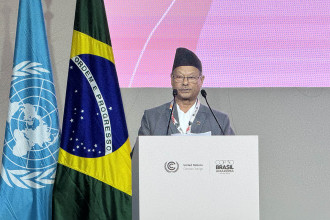
KATHMANDU: The Executive Board of the International Monetary Fund (IMF) last Tuesday completed the fourth review under the four-year Extended Credit Facility (ECF) for Nepal. With the completion of the review, Nepali authorities can now withdraw approximately SDR 31.4 million (equivalent to about $41.3 million). This disbursement adds to the total ECF support, which has reached SDR 188.3 million (approximately $247.7 million). The ECF programme, approved by the IMF Executive Board in January 2022, has been instrumental in mitigating the economic impact of the pandemic and global shocks. It aims to protect vulnerable groups, maintain macroeconomic stability, and catalyse additional financing from development partners.
Looking ahead, Nepal faces challenges: its growth rate, projected at around 3% for FY2023/24, remains below potential due to subdued domestic demand and post-pandemic balance sheet adjustments. However, there are positive signs. Economic activity is expected to improve, with growth reaching 4.9% in FY2024/25, supported by stronger domestic demand. The country's cautiously accommodative monetary policy, planned capital expenditure increase in the FY2024/25 budget, additional hydropower generation, and rising tourist arrivals are all factors contributing to this outlook. Inflation is expected to stay within the Nepal Rastra Bank's target ceiling of 5.5%.
Despite progress, risks persist. Nepal must accelerate capital project execution to stimulate the economy. Fragile political stability could disrupt reforms, and financial sector vulnerabilities — such as non-performing loans (NPLs) and cooperative lender failures — pose threats. Externally, high commodity prices may hinder recovery in energy-intensive sectors. Additionally, Nepal's vulnerability to natural disasters remains a concern.
Following the Executive Board discussion, Bo Li, Deputy Managing Director and Acting Chair, made the following statement:
"Nepal has made important strides on its economic reform agenda. Decisive actions in monetary policy and bank regulation helped overcome balance of payments pressure. Fiscal discipline was maintained despite revenue shortfalls. To sustain growth and fiscal stability, Nepal should execute planned capital spending, enhance public investment management, and improve fiscal transparency."
Given the current context of balance sheet repair and weak monetary policy transmission, Nepal should maintain a cautious and data-dependent approach to monetary policy. This strategy aims to safeguard price stability and external equilibrium. Strengthening Nepal's financial system remains a priority, with a focus on creating regulatory frameworks that encourage sustainable credit growth while proactively addressing vulnerabilities in the savings and credit cooperatives sector. It's crucial to uphold recent reforms related to lending practices and asset classification, especially as preparations continue for the loan portfolio review of the ten largest banks.
Nepal's commitment to enhancing its anti-money laundering and countering the financing of terrorism (AML/CFT) framework is commendable. Recent amendments to fifteen laws, including those related to money laundering, align Nepal's legal framework with international standards. Ensuring the effectiveness of this new framework is essential. Additionally, implementing the 2021 IMF Safeguards Assessment recommendations regarding the Nepal Rastra Bank (NRB) Act and NRB audit should be a priority.
To foster investment and achieve more inclusive growth, Nepal must continue making structural progress. This involves improving the business climate, investing in human capital, and enhancing social safety nets. Specifically, full execution of the child grant budget should be prioritised, followed by expanding the programme to cover all districts in Nepal.
READ ALSO:
- IMF delegation reviews Nepal’s fiscal progress to allocate $42m as final instalment of ECF
- IMF Executive Board completes third review of Nepal ECF
- IMF EB concludes 2023 Article IV Consultation with Nepal, completes 1st, 2nd reviews under ECF
- Asia-Pacific economy to grow at 4.5 pc in 2024: IMF
- IMF approves immediate release of final $1.1 bn instalment of $3bn bailout to Pakistan
- IMF outlook worsens for a 'limping' world economy. Mideast war poses new uncertainty






-1763462249.jpg)